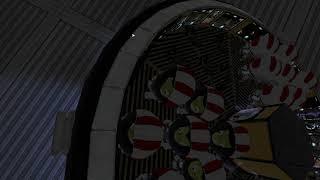
Handling Pressurized Systems with Finite Element Analysis
#Vessel #analysis #simulation #Mesh #Nonlinear #ASME #EN13445 #NFX #structureanalysis #CFD
To avoid catastrophic scenario the design of pressure vessels is often strictly regulated by codes in order to ensure that the products are safe and functional. Today two commonly used codes for pressure vessels operating in the process industry are the American ASME VIII Division 2 and its European counterpart EN 13445-3. Both of them provide rules and minimum requirements for the design, materials, fabrication, and inspection of boilers and pressure vessels. Other know codes are British Standard 5500 , currently available as Published Document PD 5500 by the British Standard Institution, AD Merkblätter: German standard, harmonized with the Pressure Equipment Directive. What is important, both codes provide two design sections, which are offering to approaches for the design. Their names are: Design by Rule or Design by Formulae and Design by Analysis.
Design by Analysis criteria are written in terms of design checks. Design checks are given to protect against four different failure modes. Methods are described for evaluating against gross plastic deformation, which is the basic static failure mechanism considered by DBA of ductile pressure vessels, incremental plastic collapse, buckling and cyclic load. For DBA two routes exist: the linear stress classification route and the direct route which refers to inelastic analyses.
For the elastic stress analysis method a linear elastic model is used. This means that the stress in the material is assumed to be linearly proportional to the strain also above the yield stress. This method is also called stress classification.
The limit-load method assumes an elastic perfectly-plastic material where the stress is assumed to increase linearly proportional until the yield stress. Thereafter the stress is constant, independent of the magnitude of the strain. By calculating at what loads the structure will collapse it can be dimensioned.
The most advanced method is the elastic-plastic stress analysis method which can also utilize a nonlinear elastic-perfectly plastic material model. This is the most accurate way to model the material behavior but also the most resource intensive (Sunnersjö, 1999).
The ―Stress classification method, which this project is limited to, is included in the analysis for plastic collapse and thus, this is the only failure mode that will be considered. The other failure modes must be analyzed explicitly but are out of scope for this project. Several different methods are suggested by the code for each failure mode, but the code does not give any recommendation of which method to use and leaves it to the user to determine which is the most suitable depending on the specific cumstances (ASME, 2010).
At this moment let me make small comparison between just mentioned approaches. Starting from DBR, this section contain set of design rules based on strength of materials equations and empirical formulae and the designer simply follows the rules laid out in the procedures for components such a nozzles, heads, cylinders, flanges and so on. For example, there are cases when the loadings and geometries are such that the procedure cannot be applied effectively. This happens when designs are more complex and it becomes difficult to apply this approach without big margin of safety.
To cover the design of more complex shapes a DBA section was written to use results from numerical analyses and based on that make the design more accurate and opened for more complex configurations. DBA mainly prescribes criteria for any loads and geometries which are not explicitly covered by DBR. This design approach provides a rational safety margin (not unduly
excessive) based on the actual stress profile and optimizes design to conserve material, leading to consistent reliability and safety.
To avoid catastrophic scenario the design of pressure vessels is often strictly regulated by codes in order to ensure that the products are safe and functional. Today two commonly used codes for pressure vessels operating in the process industry are the American ASME VIII Division 2 and its European counterpart EN 13445-3. Both of them provide rules and minimum requirements for the design, materials, fabrication, and inspection of boilers and pressure vessels. Other know codes are British Standard 5500 , currently available as Published Document PD 5500 by the British Standard Institution, AD Merkblätter: German standard, harmonized with the Pressure Equipment Directive. What is important, both codes provide two design sections, which are offering to approaches for the design. Their names are: Design by Rule or Design by Formulae and Design by Analysis.
Design by Analysis criteria are written in terms of design checks. Design checks are given to protect against four different failure modes. Methods are described for evaluating against gross plastic deformation, which is the basic static failure mechanism considered by DBA of ductile pressure vessels, incremental plastic collapse, buckling and cyclic load. For DBA two routes exist: the linear stress classification route and the direct route which refers to inelastic analyses.
For the elastic stress analysis method a linear elastic model is used. This means that the stress in the material is assumed to be linearly proportional to the strain also above the yield stress. This method is also called stress classification.
The limit-load method assumes an elastic perfectly-plastic material where the stress is assumed to increase linearly proportional until the yield stress. Thereafter the stress is constant, independent of the magnitude of the strain. By calculating at what loads the structure will collapse it can be dimensioned.
The most advanced method is the elastic-plastic stress analysis method which can also utilize a nonlinear elastic-perfectly plastic material model. This is the most accurate way to model the material behavior but also the most resource intensive (Sunnersjö, 1999).
The ―Stress classification method, which this project is limited to, is included in the analysis for plastic collapse and thus, this is the only failure mode that will be considered. The other failure modes must be analyzed explicitly but are out of scope for this project. Several different methods are suggested by the code for each failure mode, but the code does not give any recommendation of which method to use and leaves it to the user to determine which is the most suitable depending on the specific cumstances (ASME, 2010).
At this moment let me make small comparison between just mentioned approaches. Starting from DBR, this section contain set of design rules based on strength of materials equations and empirical formulae and the designer simply follows the rules laid out in the procedures for components such a nozzles, heads, cylinders, flanges and so on. For example, there are cases when the loadings and geometries are such that the procedure cannot be applied effectively. This happens when designs are more complex and it becomes difficult to apply this approach without big margin of safety.
To cover the design of more complex shapes a DBA section was written to use results from numerical analyses and based on that make the design more accurate and opened for more complex configurations. DBA mainly prescribes criteria for any loads and geometries which are not explicitly covered by DBR. This design approach provides a rational safety margin (not unduly
excessive) based on the actual stress profile and optimizes design to conserve material, leading to consistent reliability and safety.
Комментарии:
Saucy saucer
None (Cataclysmm)
Handling Pressurized Systems with Finite Element Analysis
midas NFX(Global)
Detachment - Open Your Heart
blodiapunchingjin
FAQ - What's Included in a Bruiser Conversions JKCrew
Bruiser Conversions
how to bypass subscription
Yuppy Newupdate
Reinstall Gaming Services | Windows 10 | Windows 11
ComeAndFixIT
Bà Nguyễn Phương Hằng không 'quất' ông Thích Minh Tuệ vậy là ai?
Hồ Văn Thuận 1991
Damon and Pythias Open Court Read Aloud
Kalynn In Second
INSANE ONLINE RACE WITH LAMBORGHINI AVENTADOR SVJ! Racing Master
M.Muneeb.R Gaming


























